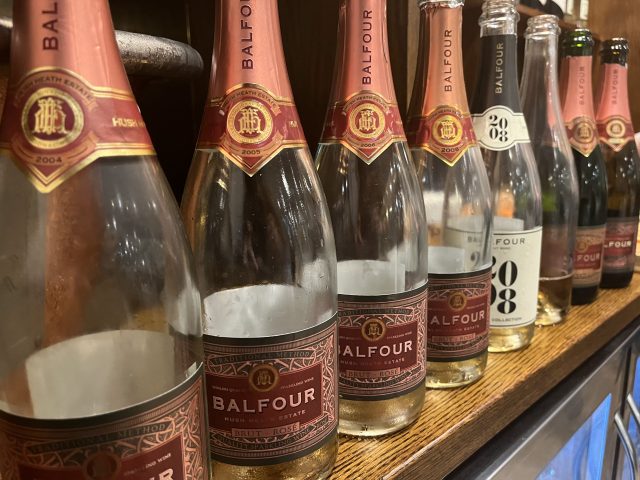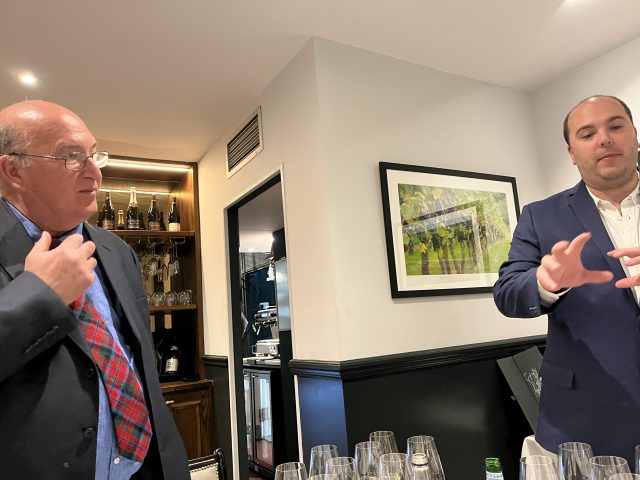This website uses cookies so that we can provide you with the best user experience possible. Cookie information is stored in your browser and performs functions such as recognising you when you return to our website and helping our team to understand which sections of the website you find most interesting and useful.
Balfour Winery celebrates 20 years
At a tasting marking 20 years since the first vines were planted at Hush Heath Estate, the team at Balfour Winery reflected on the evolving style of its brut rosé, the emergence of English still wines, and the contentious issue of PDOs.

When husband and wife Richard Balfour and Leslie Balfour-Lynn began to formulate the idea of making their own wine in the early 2000s, they were unsure of how successful an English wine producer could be. As Balfour succinctly put it: “our philosophy was ‘if we can’t sell wine, we’ll drink it’.”
Two decades on, and Balfour explained that the eventual aim is to produce 750,000 to one million bottles a year, though he insisted that the estate’s “raison d’être” remains “wine tourism and having fun”. Indeed, though the Balfour Winery range has expanded to cover everything from still reds to canned fizz, the Balfour Brut Rosé remains the star of the lineup.
Father and son team Owen and Fergus Elias are the winemakers behind that range. Balfour compared Owen to a “brilliant chef”: “He doesn’t work to a formula, and he’s difficult to manage!”

But the winemakers have relished the challenge of meeting the height of Balfour’s ambition, as Owen, who left Chapel Down to join Balfour, explained: “Richard wanted to make something better than Billecart-Salmon.” As with Billecart-Salmon, the wine’s hue matters a great deal, as Owen put it: “We spend quite a long time with Richard in the lab discussing the colour!”
On the issue of freshness, Owen said: “I like to have riper fruit than a lot of English sparkling producers – I wait for the acid to drop. The Balfour is generally a non-malo wine.” Fergus later added that he felt the lack of malolactic fermentation increases the ageing potential of the wines.
The 2004 Balfour Brut Rosé, disgorged in 2008, still remains fresh on the palate, a trait which led Balfour to describe the vintage as “the biggest surprise”.
Six years later, the 2010 was the first made at the Balfour winery. Though it was a “lean year” and the wine produced was “a bit of a slow burner,” in Owen’s words, time has worked its magic and created something complex and elegant.
The proportion of Meunier in the blend has increased over time, though it is absent in the 2004 as it had only been planted the previous year, going from 4% in the 2005 to 30% in the 2018. Explaining this rise in relation to the percentages of Chardonnay and Pinot Noir, Owen claimed: “the Meunier is still often the star of our vintage.”
The 2018, which is the winery’s current release, still has its pale pink hue and is yet to acquire the golden tint of its older predecessors.
Fergus said: “We have mixed favourites…they’ve all got nice limey, orangey marmalade bits and interesting, mature flavours…always herby, and a bit salty at the end.”
Beyond English sparkling, the winery is also pushing the boat out with its still wines. Balfour remarked: “Who’d have thought that England would produce still red wines?” In response to which Owen raised his hand. Indeed, the Gatehouse (RRP: £60), an oak-aged Pinot Noir from the estate, was among the still wines from the Winemakers’ Wines series showcased.
Reflecting on the growth of Balfour Winery’s range, Fergus remarked: “our remit is so broad, we’re at both ends of the market…there is something very lovely about our ethos.”
Though the future of English wine looks bright, the scorching summer temperatures this year highlighted how climate change is a double-edged sword for the industry. Balfour noted that “extreme weather patterns”, whether it be hail, rain, frost or drought, can be highly disruptive and destructive to viticulture.
As the tasting concluded, attention turned to the county rivalling Kent for its winemaking. While WineGB CEO Simon Thorpe suggested that the backlash against the Sussex Sparkling Wine PDO was not a “true reflection of things”, the mood in the room suggested that the rivalry between the two counties stretches to more than just cricket.
Balfour argued: “The problem is that in England, PDO means nothing, but internationally it means something…Should we create a Kent PDO if it means nothing nationally?” The general consensus from those Balfour employees in attendance was no.
“If you travel to America or Japan,” Balfour explained, “they talk about it [PDOs] – it’s perceived as premium.” While there is no Kent wine PDO, Balfour is one of a number of wineries that is a member of Kent’s Wine Garden of England group.
Of the county’s current lack of a PDO, Owen Elias joked: “it’s the Wild West out here!”
On the other side of the River Rother, Sussex Sparkling producer Rathfinny Estate has a rather different view of PDO status.

